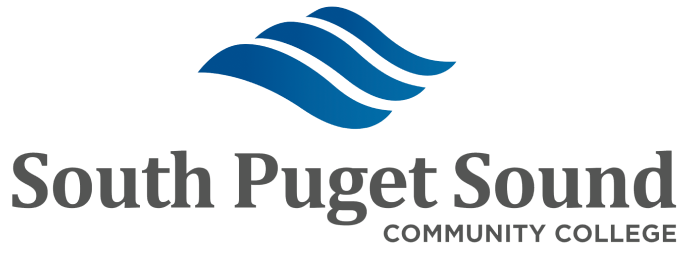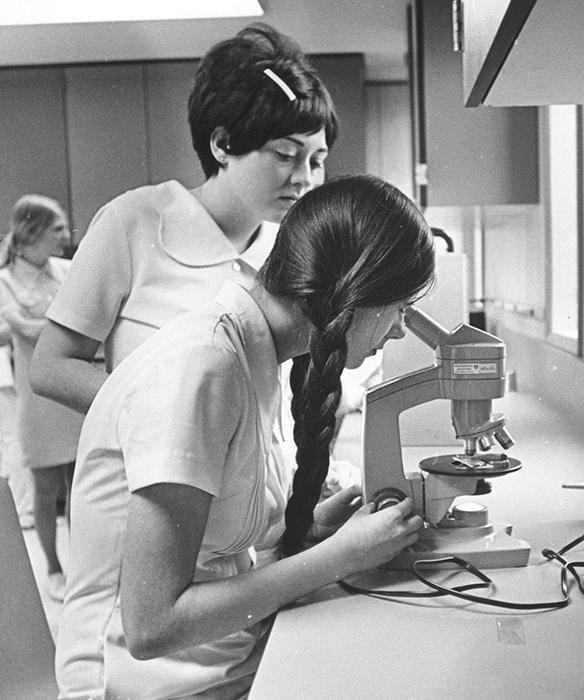Olympia Vocational Technical Institute (OVTI)
In September 1962, the Olympia School District founded the current college as Olympia Vocational Technical Institute (OVTI). With roots in adult education at Olympia High School, OVTI was housed in downtown Olympia’s Montgomery Ward Building.
OVTI thrived in its downtown home, adding programs and meeting the community’s adult vocational education needs. In 1967, the passage of the Community College Act presented a decision for OVTI: stay with the Olympia School District or join the state community college system. That choice led to the institute merging into District 12 with the long-established Centralia College.
Olympia Technical Community College (OTCC)
Groundbreaking for the current Olympia Campus occurred on July 8, 1970. In 1976, OVTI became Olympia Technical Community College (OTCC) and had the unique distinction of being the only community college in the state devoted entirely to technical education.
South Puget Sound Community College (SPSCC)
The early 1980s brought growth to the college’s mission, scope, and physical setting. It offered its first Associate of Arts degree to several hundred students in 1982. More programs were added. Thirty-one additional acres were added to the Olympia Campus in 1982. The college selected its new mascot, the “Clipper,” replacing the previous turtle mascot “Ovie” (OV).
In 1984, recognizing the college’s broadened mission, the name changed once again, this time to South Puget Sound Community College. A few years later, in 1988, the college split from District 12 in 1988 to form its own autonomous district, District 24.
SPSCC Expansion: Hawks Prairie Center, Olympia Campus, and Lacey Campus
To better meet the needs of growing north Thurston County, the college opened a branch center in Lacey at the Hawks Prairie Village Mall in 1995, known as the Hawks Prairie Center. With the opening of the Lacey Campus, this branch center later closed in 2015.
The 2000s marked a new era of growth for the Olympia Campus. Close to a dozen new buildings were built, including the new Center for Student Success (Building 22), the Automotive, Welding, and Central Services Building (16), the Social Sciences Building (23), the Natural Sciences Building (35), and the Kenneth J. Minnaert Center for Performing Arts (21).
In 2014, the college purchased the property for its Lacey Campus and began renovating over 100,000-square-feet of existing office space. In early 2015, SPSCC’s Machining Technologies program set up shop in Building 3 of the Lacey Campus, followed closely by the opening of Building 1 in September 2015. Building 1 houses classrooms for credit and non-credit classes, event space, a testing center, student services, and the Center for Business & Innovation, a co-located partnership with the Thurston Economic Development Council.
Present Day: Craft Brewing & Distilling Building and Dr. Angela Bowen Center for Health Education
In 2018, SPSCC launched its Craft Brewing & Distilling program, the only program of its kind in the nation. In Fall 2020, the program moved into its new home at the Craft Brewing & Distilling Building located in the Tumwater Craft District. This space includes classrooms, labs, small scale production space, offices, and a conference room.
In October 2022, SPSCC celebrated the grand opening of the Dr. Angela J. Bowen Center for Health Education. The Bowen Center was acquired in January 2019 and now houses the SPSCC Foundation and Nursing and Medical Assisting programs. Named in honor of Dr. Angela Bowen, an Olympia physician, medical research pioneer, and philanthropist who passed away in 2017, the SPSCC Foundation was gifted a $1.19 million in-kind contribution by Dr. Bowen and her estate to support the purchase of the building, the largest gift of its kind in college history.
Today, approximately 5,000 students each quarter seek education at the campuses of South Puget Sound Community College. The college remains responsive to the changing educational needs of the district’s residents, and plays a prominent role in a county that is fortunately rich in higher education opportunities.
* For more information, see A History of South Puget Sound Community College (1957-2006), by Lois Fenske

